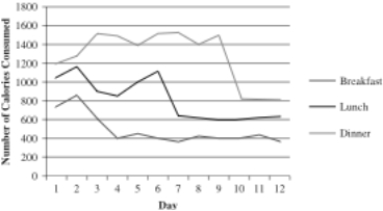Multiple Choice
Dr. Anderson is a nutritionist who helps clients lose weight prior to surgery. She is working with W. J., a male client who is planning on undergoing a heart transplant. He currently eats more than 3,500 calories a day and has been asked by his doctor to cut the number of calories to about 1,800 (400 for breakfast, 600 for lunch, and 800 for dinner) . She is curious as to whether a food journal will help W. J. reduce the number of calories he eats. A food journal is used to record everything a person eats to help patients be more aware of what they're eating. W. J.'s wife also recorded the food he consumed at each meal to have complete data before introducing the journal. Dr. Anderson decides to phase in the food journal gradually, initially only having W. J. record what he ate at breakfast during the first three days after baseline (days 4-6) . During days 7-9, the journal is used at lunch, too, and during days 10-12, it also is used during dinner. The data for Dr. Anderson's study are below.
Which of the following aspects of Dr. Anderson's study might be susceptible to observer bias?
A) The use of the food journal to track calories consumed
B) The conversion by Dr. Anderson of the food journal entries into calories consumed
C) The use of only one manipulation (e.g., the food journal)
D) The use of only one dependent variable
Correct Answer:

Verified
Correct Answer:
Verified
Q26: The degree to which a quasi-experiment supports
Q27: Which of the following is an advantage
Q28: Which of the following topics would be
Q29: Which of the following is a difference
Q30: Lara is conducting a study for her
Q32: Dr. Fletcher is interested in whether joining
Q33: Which of the following is NOT a
Q34: Dr. Fletcher is interested in whether joining
Q35: Layne is trying to watch less television.
Q36: Dr. LaGuardia is a cognitive neuroscientist who